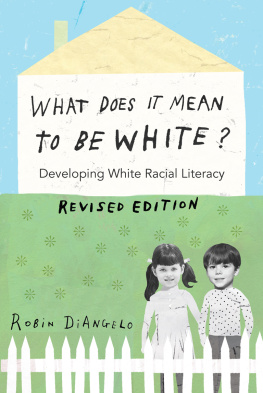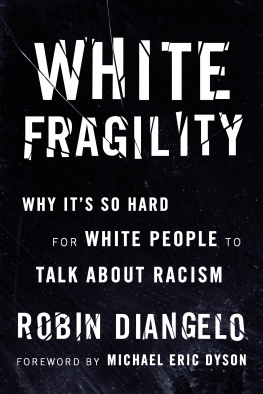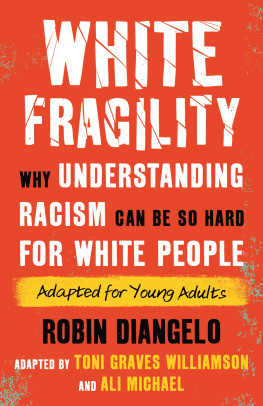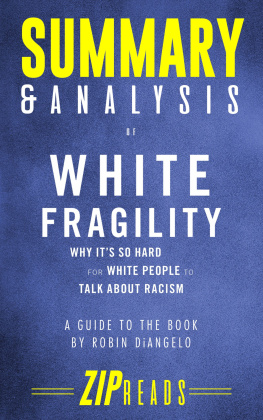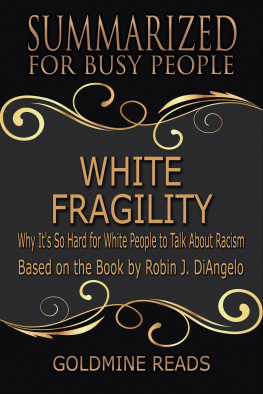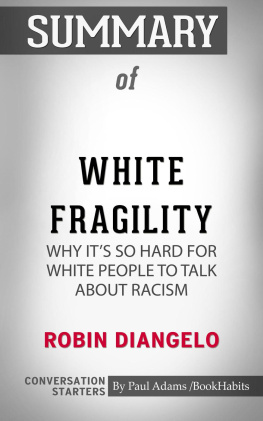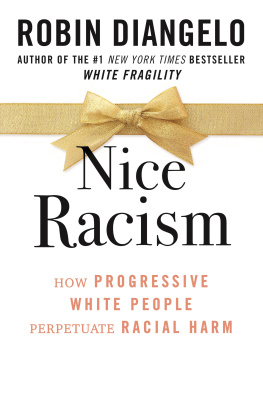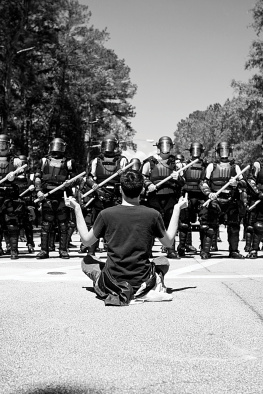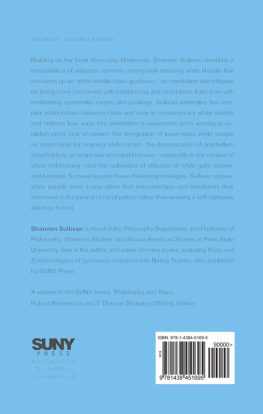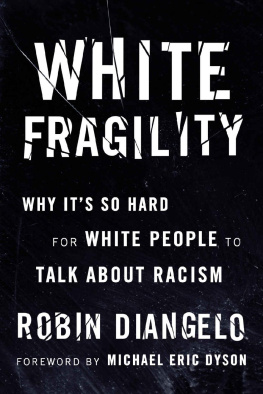Contents
Pagebreaks of the print version
Guide
PRAISE FOR WHITE FRAGILITY
White Fragility is a book everyone should be exposed to. With any luck, most who are will be inspired to search themselves and interrupt their contributions to racism.
Shelf Awareness, Starred Review
A valuable guide... While especially helpful for those new to the critical analysis of whiteness, this work also offers a useful refresher to anyone committed to the ongoing process of self-assessment and anti-oppression work.
Library Journal
I have been wild about DiAngelos book since I read it last year because the associate professor of education at the University of Washington at Seattle is a white woman writing unflinchingly to white people about race. DiAngelo forces white people to see and understand how white supremacy permeates their lives and to recognize how they perpetuate it. More importantly, she shows them what they can do to change themselves and dismantle this pernicious system.
JONATHAN CAPEHART , Washington Post
The value in White Fragility lies in its methodical, irrefutable exposure of racism in thought and action, and its call for humility and vigilance.
The New Yorker
Robin DiAngelos White Fragility brings language to the emotional structures that make true discussions about racial attitudes difficult. With clarity and compassion, DiAngelo allows us to understand racism as a practice not restricted to bad people. In doing so, she moves our national discussions forward with new rules of engagement. This is a necessary book for all people invested in societal change through productive social and intimate relationships.
CLAUDIA RANKINE
As a woman of color, I find hope in this book because of its potential to disrupt the patterns and relationships that have emerged out of longstanding colonial principles and beliefs. White Fragility is an essential tool toward authentic dialogue and action. May it be so!
SHAKTI BUTLER , president of World Trust and director of Mirrors of Privilege: Making Whiteness Visible
As powerful forces of white racism again swell, DiAngelo invites white progressives to have a courageous conversation about their culture of complicity.... White Fragility provides important antiracist understanding and essential strategies for well-intentioned white people who truly endeavor to be a part of the solution.
GLENN E. SINGLETON , author of Courageous Conversations About Race
Robin DiAngelo demonstrates an all-too-rare ability to enter the racial conversation with complexity, nuance, and deep respect. Her writing establishes her mastery in accessing the imaginal, metaphoric mind where the possibility for transformation resides. With an unwavering conviction that change is possible, her message is clear: the incentive for white engagement in racial justice work is ultimately self-liberation.
LETICIA NIETO , coauthor of Beyond Inclusion, Beyond Empowerment
White Fragility is the secret ingredient that makes racial conversations so difficult and achieving racial equity even harder. But by exposing it and showing us allincluding white folkshow it operates and how it hurts us, individually and collectively, Robin DiAngelo has performed an invaluable service. An indispensable volume for understanding one of the most important (and yet rarely appreciated) barriers to achieving racial justice.
TIM WISE , author of White Like Me: Reflections on Race from a Privileged Son
White Fragility is a must-read for all educators because racism and racial disparities in access and opportunity continue to be an urgent issue in our schools. As educators, we need to summon up the courage and together act deliberately and honestly to develop the skills we need to engage in conversations about bias, race, and racismespecially our own.
VAL BROWN , professional development facilitator and founder of #ClearTheAir
As Robin talked about, it is critical for white peoplefor people in generalto stop denying their racist ideas, to stop denying the ways in which policies have benefited them, to stop denying their racism and to realize that actually the heartbeat of racism itself is denial and the sound of that heartbeat is Im not racist.
IBRAM X. KENDI
on Good Morning America

This book is dedicated to Anika Nailah, a brilliant anti-racist activist, educator, poet, performance artist, writer, and mentor. Thank you, my friend. May you be able to tell theyve read the book.
INTRODUCTION
When Carolyn walked into the orientation session, she inwardly rolled her eyes and let out a sigh. Here we go again, she thought, as she looked out at a veritable sea of well-meaning whiteness. She was attending the orientation to learn more about an organization that described itself as committed to social justice. While the organization was overwhelmingly white, they were working hard to educate themselves on various forms of oppression. This wasnt the first time she was the only Black person in the room, but Carolyn reasoned that at least these white people were committed social progressives. She joined and started attending a weekly subgroup where she wasyet againthe only person of color in the room.
At the end of the sixth week the facilitator, a white male, informed her that the next week they would be studying racism and asked her if she would teach that session. She told him she needed to think about it, and then she called me, in a state of distress.
Carolyn and I have been friends and colleagues for over twenty years. We met when we were both hired as facilitators of a mandated equity training for a government organization. Since that time, we have co-led countless anti-racism sessions and been through many of our own personal challenges navigating a long-term interracial friendship. Her mentorship has had a profound impact on my understanding of systemic racism.
When Carolyn called me that day, she was torn: on the one hand, she wanted to give them this information because they desperately needed it; on the other hand, to be the only Black person in the group and have to explain how racism manifestedboth in general and in the group itselfwas terrifying. She risked being subjected to the patterns of white fragility that are all too common when white people are challenged on race: minimization, defensiveness, anger, invalidation, hurt feelings, guilt. Would she be seen as an aggressor as they positioned themselves as victimized? Would she lose valued relationships? Would this be her last session in the group?
She decided that she would share her experience as a Black person if I came with her and also spoke to themspecifically as a white personabout white patterns of racism. She well understood that white people are generally more receptive to hearing about racism from other white people. My presence would also ensure that she had a trusted ally at her side to support her. I agreed.
As the days passed and she prepared her presentation, she called me many times to vent her fear and anxiety. The request to teach an all-white group about racism took a tremendous toll on Carolyn. In addition to the emotional work she was doing, she spent hours preparing her presentation, trying to make it indisputable so she would not be negated. Being in front of an all-white group also triggered in her a lifetime of racist abuse from white teachers, schools, and society at large. She was up against the relentless messages that as a Black woman, she was unintelligent and had no knowledge of intrinsic value.


